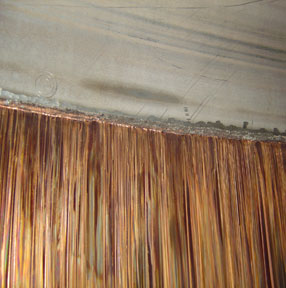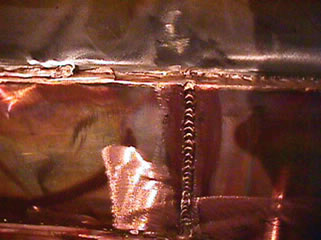Custom Fabricator Taps Miller's Auto-Line Technology, Keeps Business Brewing
Print Article
Pro Engineering fabricators rely on the flexibility of the XMT 350 CC/CV multiprocess inverter with Auto-Line from Miller Electric Mfg. Co. to deliver quality, custom fabrication solutions to their customers.
Think Beer, bratwurst and cheese and Milwaukee, Wisconsin may come to mind. In 1977, Ed Michalski had a hunger to start his own business, so he set his sights on the industries that made Milwaukee famous and established Pro Engineering and Manufacturing Incorporated. Thirty years later, Michalski’s company is considered a leader in custom fabrication, manufacturing and engineering for the food and beverage industries.
In fact, to support its growth, Pro Engineering recently moved to a new 33,000-sq. ft. manufacturing facility complete with 30-ft high ceilings, 16- by 20- foot dock doors, 5- and 10- ton overhead cranes and state-of-the-art welding equipment. Whether in their manufacturing facility or at an off-site project, Pro Engineering fabricators rely on the flexibility of the XMT 350 CC/CV multiprocess inverter with Auto-Line from Miller Electric Mfg. Co. to deliver quality, custom fabrication solutions to their customers.
Brew Kettle Maintenance and Repair
When 150-year old Milwaukee-based Miller Brewing Company needed assistance with their extensive brew kettle repair project, they tapped Pro Engineering experts for advice. A particularly unique and difficult welding application, the project involved repairing damaged copper and stainless steel joints within Miller Brewing’s six massive brew kettles. Over a period of time, mechanical, chemical and electrolytic erosion degraded the copper and stainless steel interface where the brew kettle’s sidewall and dome meet. In certain areas of the brew kettle, the original copper weld used to bond the stainless steel dome to the copper kettle began to show serious signs of wear (see Figure 1).
 |
Figure 1: Electrolytic, mechanical and chemical erosion degraded the copper (below) sidewall and stainless steel dome joint located inside one of Miller Brewing Company’s brew kettles.
|
To repair the damaged interface, Pro Engineering engineers designed and fabricated a 6-inch wide copper band to bridge the original stainless steel/copper weld seam. Taking advantage of Miller Electric’s XMT 350’s multi-process capabilities, Pro Engineering fabricators used a combination of MIG and TIG welding to bond the copper band to each of the base metals.
Using the XMT 350 and Miller Electric’s S22A wire feeder operating at 325 amps and 25 volts, fabricators MIG welded the bottom portion of the copper ring to the 3/8-inch thick brew kettle copper sidewall using .035-inch diameter copper solid wire. Fabricators also used Smith Equipment gas regulators to deliver 100-percent helium shielding gas.
To weld the upper portion of the copper band to the 1/4-inch stainless steel dome, fabricators first TIG welded a root pass using a Weldcraft torch with 3/32-inch diameter tungsten and .035-inch diameter silica bronze (AWS-A5.7/ER Cu Si) filler rod. Because TIG welding produces lower deposition rates, fabricators MIG welded the remaining fillet welds using silica bronze solid wire operating at 275 amps and 25 volts. Due to copper’s excellent heat transfer, fabricators used a secondary heat source to achieve and maintain the weld pool (see Figure 2). “We manually used Mapp torches to heat the area either directly below or on the opposite side of the work piece,” explains Michalski.
Although Pro Engineering fabricators heavily rely on the XMT 350s multi-process capabilities, fabricators equally value the machine’s primary power flexibility, especially when they are working at off-site projects. The XMT 350’s Auto-Line Power Management Technology, exclusive to Miller Elec., gives Pro Engineering operators the ultimate power flexibility. Auto-Line allows the XMT 350 to produce a rock-steady arc—even through primary power fluctuations—within a 190 to 630V range and accepts any type of primary power supply (190 to 630V, single- or three-phase, 50 or 60 Hz).
 |
Figure 2: Pro Engineering fabricators MIG and TIG welded a 6-inch wide copper band to bridge the original copper and stainless steel joint.
|
The XMT 350’s Auto-Line Circuit internally boosts primary power to a high voltage. Once it’s regulated, the power becomes the source for the actual inverter section of the XMT. Auto-Line ensures that the inverter has sufficient power as long as the primary power remains within a +37/-59 percent of the nominal 460V power.
The XMT 350’s Auto-Line Technology proved useful during the brew kettle maintenance repair project where Miller Brewing’s brew house was running 230 volt service. “In the past we’ve lost machines because of voltage problems,” says Michalski. “I like my XMT 350’s flexibility because I can move it from place to place without having to worry about the primary power supply.”
The XMT 350 delivers 350 amps at 60% duty cycle with a maximum output of 425 amps. The XMT 350s ability to produce a stable, steady welding arc through input voltage fluctuations makes the machine simpler to use and helps Pro Engineering deliver quality products.
“The XMT 350 is very easy to use and allows us to control the quality of our products,” says Michalski. For a leading manufacturing, fabrication and engineering company like Pro Engineering, crafting meticulous custom products is key to earning the business and confidence of industry-leading clients such as Miller Brewing Company.